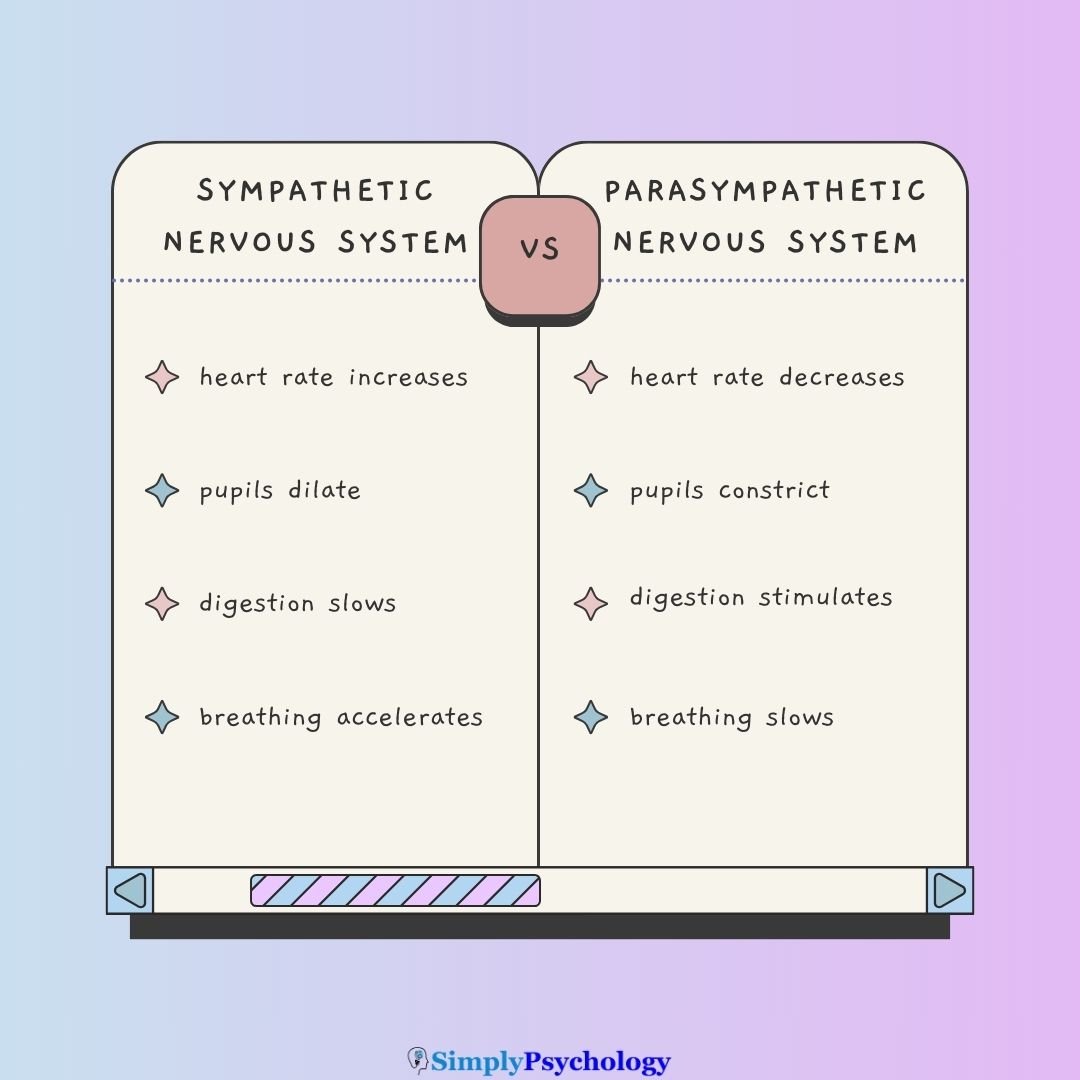The parasympathetic nervous system (PSNS) is one of two main divisions of the autonomic nervous system, which controls involuntary body functions like heartbeat, digestion, and breathing.
Known as the “rest and digest” system, the PNS slows down bodily activity after stress, helping your body return to a calm, balanced state. It works in opposition to the sympathetic nervous system (SNS), which is responsible for the “fight or flight” response.

How the Parasympathetic Nervous System Works
The PNS operates automatically, without conscious effort. It sends signals from the brain and lower spinal cord to major organs to slow things down, promote digestion, and encourage recovery.
Key components of the PNS include:
- Cranial nerves, especially the vagus nerve, which makes up about 75% of the parasympathetic system and reaches organs like the stomach, bladder, and heart.
- Spinal nerves from the sacral region (S2-S4) that support bladder and reproductive functions.
- Neurotransmitter: The PNS primarily uses acetylcholine, a chemical messenger that slows heart rate, stimulates digestion, and promotes glandular secretions.
Key functions of the parasympathetic nervous system
The parasympathetic nervous system helps regulate many everyday functions that keep your body healthy and balanced.
Key functions of the PSNS include:
- Slowing heart rate and breathing to resting levels
- Constricting pupils to reduce light intake in relaxed conditions
- Stimulating digestion through increased salivation and intestinal movement
- Promoting urination by contracting the bladder
- Facilitating bowel movements via intestinal contractions
- Producing tears to lubricate and protect eye tissue
- Releasing bile to help digest fats
Imagine you've just finished giving an important presentation at work. As you sit back down at your desk, you notice your racing heart begins to slow, your tense muscles start to relax, and your churning stomach settles enough that you're actually feeling hungry.
These calming sensations are your parasympathetic nervous system at work, helping your body return to its normal, relaxed state after the stressful event has passed.

Why the parasympathetic nervous system is important
Chronic stress keeps the sympathetic system in overdrive, which can lead to high blood pressure, digestive issues, sleep problems, and anxiety.
The parasympathetic system helps counterbalance this stress, protecting both physical and mental health.
For example, after a tense meeting or a near accident, the PNS kicks in to slow your heartbeat, relax your muscles, and bring your body back to baseline.
Over time, a well-functioning PNS helps:
- Improve digestion
- Lower stress levels
- Support cardiovascular health
- Promote restorative sleep
Parasympathetic vs. sympathetic nervous system
Think of the parasympathetic and sympathetic systems as a brake and gas pedal.
The sympathetic nervous system gets you ready for action (increased heart rate, energy mobilization), while the parasympathetic system helps you slow down and recover.
| Function | Sympathetic (Fight or Flight) | Parasympathetic (Rest and Digest) |
|---|---|---|
| Heart rate | Increases | Decreases |
| Pupils | Dilate | Constrict |
| Digestion | Slows | Stimulates |
| Breathing | Accelerates | Slows |
| Salivation | Inhibits | Stimulates |
| Bladder | Relaxes | Contracts |

Signs of Parasympathetic Dysfunction
When the parasympathetic system isn’t working properly, your body may struggle to calm down or recover after stress. Common symptoms include:
- Persistent high heart rate or blood pressure
- Digestive problems (e.g., constipation or diarrhea)
- Poor bladder control
- Dry mouth or eyes
- Light sensitivity due to pupil dysfunction
- Feeling “stuck” in a stressed or anxious state
Causes of dysfunction may include diabetes, aging, neurological conditions like Parkinson’s disease, or nerve injury.
What Happens When It’s Overactive?
An overactive parasympathetic system, although less common, can also cause problems. Excess acetylcholine in the body may lead to:
- Muscle cramps or weakness
- Blurred vision or excessive tearing
- Excessive saliva or digestive activity
- Diarrhea or low blood pressure
In rare cases, severe overactivation may cause fainting or paralysis.
Activating Your Parasympathetic Nervous System
Fortunately, there are simple techniques that can activate your PNS and help your body relax and recover:
- Deep breathing: Long, slow exhales (e.g., box breathing: inhale 4, hold 4, exhale 4, hold 4)
- Mind-body practices: Yoga, tai chi, or gentle stretching
- Meditation and mindfulness: Encourage calm awareness and reduce SNS activity
- Progressive muscle relaxation: Tense and relax muscle groups to trigger calm
- Cold exposure: Brief exposure to cold water can stimulate the vagus nerve
These activities signal safety to your nervous system and help bring your body back into balance.
Britannica, T. Editors of Encyclopaedia (2019, September 6). Parasympathetic nervous system. Encyclopedia Britannica. https://www.britannica.com/science/parasympathetic-nervous-system
Lumen. (n.d.). Functions of the Autonomic Nervous System. Retrieved May 5, 2021 from https://courses.lumenlearning.com/boundless-ap/chapter/functions-of-the-autonomic-nervous-system/
Nall, R. (2020, April 23). Your Parasympathetic Nervous System Explained. Healthline. https://www.healthline.com/health/parasympathetic-nervous-system
Tindle, J., & Tadi, P. (2020). Neuroanatomy, Parasympathetic Nervous System. StatPearls [Internet].

